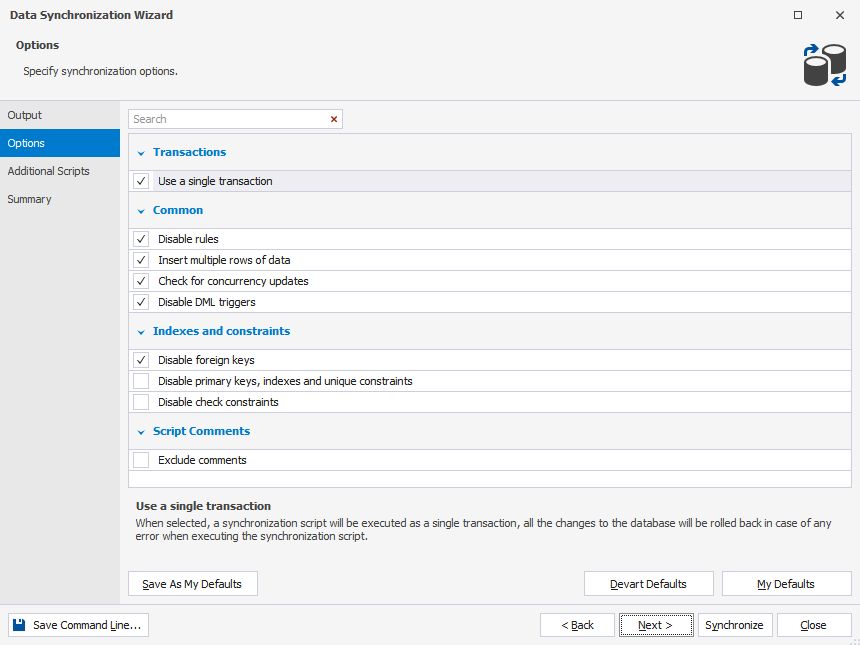Configure synchronization options
After you have selected the objects for synchronization and have configured the synchronization output, you can use the Data Synchronization Wizard to set synchronization options.
How to configure synchronization options
To configure data synchronization, click the Options tab to view all the synchronization options. For your convenience, each option has a detailed description. Note that the options can be grouped.

To configure the synchronization, select or clear checkboxes in the list of options.
To locate a required option, you can also type the search text in the Search box. The search is not case-sensitive.

Note
If you want to use the options you have set later, click Save As My Defaults.
If you want to apply options you have saved earlier, click My Defaults.
It is also possible to return to the default settings of the tool. Click Devart Defaults if you want to do it.
After you’ve configured the synchronization options, click Synchronize.
Data comparison synchronization options
| Default State | Option Name | Option Description |
|---|---|---|
| Enabled | Backup the target database | Creates a backup and allows specifying the location of the target database backup file. The backup file name will be generated in the following format: <database_name>_yyyy_MM_dd_hh_mm.bak |
| Disabled | Extension for backup file | Specifies the extension for a backup file. When the option is disabled, the default extension (.bak) will be used for a backup file. |
| Enabled | Use a single transaction | Executes a synchronization script as a single transaction. All the changes to the databases will be rolled back in case of any error when executing the synchronization script. |
| Disabled | Disable foreign keys | Drops foreign keys at the beginning of the synchronization. After the synchronization, those foreign keys are restored. |
| Disabled | Disable primary keys, indexes and unique constraints | Drops primary keys, indexes and unique constraints at the beginning of the synchronization. After the synchronization, those primary keys, indexes and unique constraints are restored. |
| Disabled | Check for concurrency updates | Supplements the UPDATE and DELETE statements with the non-key values in the WHERE condition and adds the IF NOT EXISTS statement before the INSERT statement. This will allow avoiding accidental data rewriting on live databases. |
| Disabled | Disable DDL triggers | Disables DDL triggers before the synchronization. After the synchronization, the triggers are enabled. |
| Enabled | Disable DML triggers | Disables DML triggers before the synchronization. After the synchronization, the triggers are enabled. The option is applicable to tables and views. |
| Disabled | Include print comments | Adds comments to the output when executing the synchronization script. If the print comments are included in the synchronization script, it is easier to locate the items in the output. |
| Disabled | Exclude comments | Prevents comments generation in the synchronization script. |
| Disabled | Synchronize large data via files | Creates a separate file using the OPENROWSET function for each value which size is greater than 1MB. To upload these files on a remote server, you need to specify a shared network folder accessible both from the client and the server machines. |
| Disabled | Disable rules | Drops rules at the beginning of the synchronization. After the synchronization, the rules are restored. |
| Disabled | Disable check constraints | Drops check and not null constraints at the beginning of the synchronization. After the synchronization, those constraints are restored. |
| Disabled | Insert multiple rows of data | Includes multiple rows into one INSERT statement. |